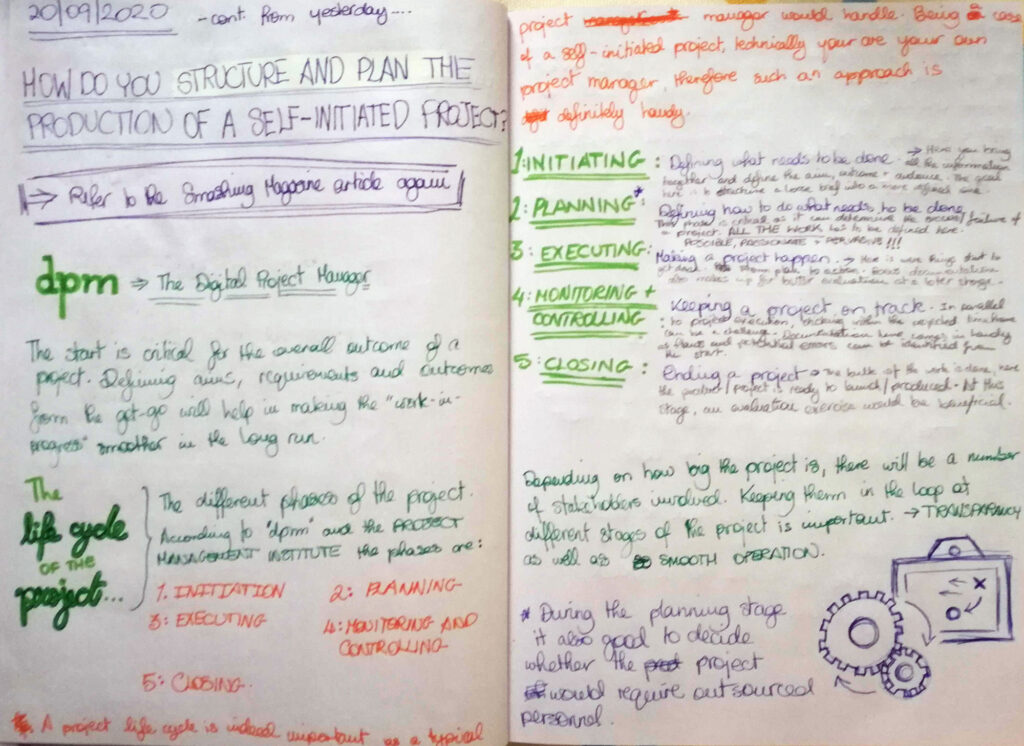
Brief Analysis – Looking At Project Frameworks and How Professionals Draft Them: Part 2

In my previous blog post, I talked about the topic of this first week of the module – brief analysis. I went over the content of the lecture as well as some of the material I looked up myself. As already mentioned in the previous blog post, the lecture was a serious of talking heads were they were asked the following two questions:
- How do you identify the subject of a self-initiated project?
- How do you structure and plan the production of a self-initiated project?
In my first blog post, I discussed in detail the first question (Read it here), where I compared the different responses of the designers in the lecture as well as talked about some sources that I had found myself. Similarly, in this blog post I will discuss in further detail the second question.
…following up from the last post.
Just like for the first question, I typed in the second question into Google to see what results came up. Amongst other things, I came across this really interesting website named The Digital Manager. At first glance it seems that the information of the website is written from a project manager’s perspective, however there is a lot of useful information that will definitely come handy in the upcoming weeks. I focused on the topic in question, that being the structuring and planning of a self-initiated project.
As with the previous articles as well as from the lecture, many experts in the field agree that the planning phase of a project is critical as it determines the outcome of the project. Defining aims, requirements and outcomes from the beginning will help in making the ‘work-in-progress’ phase run a lot smoother. Depending on the scale of the project, during the planning stage, it is important to identify all the stakeholders involved and categorise them by order of importance. This helps in determining how often meetings should the held with the stakeholders involved and what information is related to them. Furthermore, during the planning stage it is also important to decide whether the project would require any out-sourced personnel.
Another point mentioned in this article and that was also brought up by the designers at Werkflow in the lecture, was that of working in isolation. Working in isolation is not ideal. It is good to merge disciplines as it improves the overall quality of a project, from professional advice to hands-on work.
The Life Cycle of a Project
This was a very interesting way of describing the phases of the project. The project ‘life-cycle’ is split into five stages, namely:
- Initiation – Defining what needs to be done to get the project going. Something that was mentioned earlier in the article as well. At this initial stage, all the available information is brought together, the aim of the project is defined as well as the outcome/final product and the audience. The goal here is to set to structure a loose brief into a more concrete one.
- Planning – Defining how and what needs to be done. As already mentioned above, the planning phase is pivotal in the success of a project. All the necessary work needs to be defined here. One has to decide what work is possible, what is passionate and what is pervasive.
- Execution – Making a project actually happen. The project starts taking shape in this phase.
- Monitoring and Controlling – Keeping the project on track. In parallel to the execution phase, sticking within a set timeframe can be a challenge. Documentation of the execution phase is good as flaws and potential errors can be detected from the early stages.
- Closing – Ending the project. At this point the bulk of the project is done. The product should be ready for production and launch. From the creator’s side, and evaluation of the whole process is beneficial to see what worked and what needs improving.
A Short Note on Processes
Having a process is important to make a project run smoothly, however, said process should be a flexible and acts as a guide throughout the progress of the project. In many instances, processes turn out to be a constraint and can hinder progress. Therefore, one has to make sure that the process is designed to facilitate the work rather than turning into a series of rules and protocols. This works in conjunction with methodologies. There are numerous successful methodologies and they are indeed practical. However, in some cases, a process should be tailored to the specific project.
Lastly, one should not forget risk assessment during the initial stages. It is good to think ahead and hypothesise possible scenarios where problems arise. This would make up room for good contingency plans or avoid certain problems to begin with.
In Conclusion
It was a very insightful first week for this module. Will be doing some further reading on the said topic in conjunction to working on this week’s challenge. Self-initiated projects are interesting indeed, especially since you get to choose what to work on and get to work on what you like in the first place. However, as already mentioned, it requires dedication and discipline. That being said though, there is no greater satisfaction then seeing a project complete that is entirely your own from scratch.







